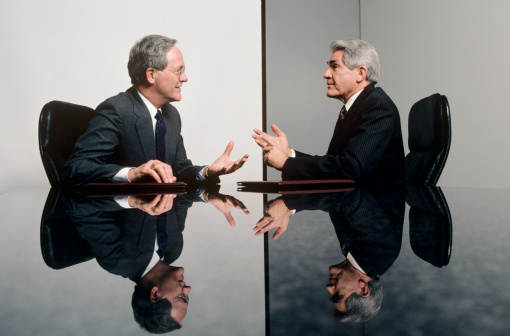- HubPages»
- Business and Employment»
- Employment & Jobs»
- Employment Advice & Tips
Using Appropriate Body Language to Get the Job!

© Nicole Paschal, All Rights Reserved
Have you ever given a presentation at work and noticed that some individuals were staring at their watches rather than paying attention? Despite your hard work, are you having trouble attaining a leadership position or promotion? Perhaps you wonder why your ideas fail to be taken seriously. Well, according to Carol Kinsey Goman and her book, “The Nonverbal Advantage,” your body language may be hindering your progression in the workplace. Knowing how to support your mental competency with the appropriate physical gestures can be the key to getting what you want out of your career and that promotion.

The 7 Second Impression
In business, that first impression is vital and according to business coach Carol Kinsey Goman it is made within 7 seconds of contact. Although you may be polite, professional, and inviting, researchers have suggested that your nonverbal cue is 4 times more impressionable than anything you may say. Although we can’t control the snap and sometimes misconstrued judgments others make of us, we can do our best to convey a specific message with our bodies. Below are 6 ways to convey a positive message upon a first meeting.
1. Correct attitude- Emotions like fear, anger, and boredom show easily in first impressions. Others are most receptive to receptiveness, curiosity, helpfulness, and happiness.
2. Smile-This one’s easy. A smile is inviting. It says “welcome.”
3. Make eye contact- It exhibits genuine interested and willingness to be open.
4. Raise your eyebrows- By lifting your eyebrows slightly more than normally, you show recognition and attentiveness.
5. Shake hands- Researchers have revealed that a single handshake establishes the same rapport as 3 hours of interaction.
6. Lean in slightly- In a business atmosphere, standing about 2 feet away is recommended. However, leaning slightly forward exhibits interest and engagement.


Space and Distance in the Workplace
If involved in a business exchange, how far you stand from your client may sometimes be more important than your sales pitch. Body language researchers tend to refer to the distance between two actors as spatial zones. Proxemics, the study of space in interaction, is also considered part of body language and influences whether we feel comfortable in our interactions.
Originated by anthropologist Edward T. Hall, he believed that territorial behavior is a product of evolution and predictable. In a new business relationship, it’s best to interact in a distance of 4 feet if involving two actors and up to 12 feet in a group setting. This sort of interaction occurs in the social zone and if you move in too soon, you may squander trust in your budding business relationship. When expressing profound interest in another actor’s proposition, it’s best to come in a bit closer at 2 to 4 feet from your conversation partner. It lets them know you’re interested, but you’re still keeping what is known as a “far personal space.” You usually can stand with friends and trusted business partners in the close personal zone, which is 1.5 to 2 feet apart.
Intimate zones tend to exist at 0 to 18 inches and can involve touching, embracing and whispering. However, such a distance is only deemed appropriate for very personal and intimate relationships. If you have business-oriented goals with your partner, such a close proximity is not recommended, even if meeting at a bar or restaurant. However, not everyone follows the rules. Research has shown that those of higher status, well-dressed individuals, and those that are considered physically attractive, are most likely to violate spatial distance boundaries in the workplace.

Selling a Message with Body Language.
Although you may be very passionate about your work, if your nonverbal communication does not convey the same enthusiasm and sense of purpose, the message may be lost. When seeking support on specific issues, not conveying your message appropriately could be detrimental to your cause. If speaking from a podium, step out and let the audience see your whole body. It provides a sense of openness. Don’t hide behind the lectern. Stand with your knees slightly bent, shoulder length apart, and weight centered. Shifting back and forth or from side to side will convey a sense of uncertainty about what you are claiming. Relax with shoulders back and use open palm gestures from time to time while speaking. Such movements are deemed inviting and honest. Interestingly, keeping your hands at your side or clasping them together in front or behind you grants the appearance of being arrested and convey a sense of dishonesty or uncertainty.
You should also look at individuals in the group or audience in front of you from time to time, but not more than 3 to 5 seconds apiece as to express sincerity in your purpose. Focusing only on one section of the audience can distract your train of thought and make the audience feel uncomfortable; therefore they are not listening to the message at hand. Also, it is vitally important to move around, but take moments to stand still and express points. Don’t rush and casual movement is ideal. Standing still and speaking in a rigid fashion can cause the viewers’ attention to flee since the human brain is innately programmed to pay attention to body movement.

The Body Language of Leadership
Although many think that leadership is only about making demands, Goman believes it is really about collaboration, influencing behavior, and displaying the right messages to others. Whether you are a manager, supervisor or CEO, do not give those beneath you mixed feelings about your investment in their work. Mixed feelings create confusion which has a negative effect on trust. Instead, your spoken words should be in sync with your body language.
As an example of what “not” to do, Goman tells the story of a CEO that visited an oil refinery. While employees wore oil soaked fire retardant jumpsuits, he wore a three-piece suit. When it was his time to speak before the crowd he took off his expensive watch and sat it on the lectern suggesting he was very busy and eager to leave. When he spoke, his first words were, “I am very happy to be here.” The CEO’S nonverbal cues countered any trust in his company’s leadership that he wished to convey.
To gain the trust and respect deserving of a good leader, you should do the following:
1. Face individuals directly. Turning away at even a quarter of an angle could show minimal interest.
2. Speak and use gestures with your palm up. It appears open and frank.
3. Be sure to continue firm eye contact. Looking away at something else in the room can show lack of interest.
4. Although it may sound a bit odd to the layperson, it is also recommended that as an effective leader you should synchronize your facial expressions, stance, and arm positions to that of your conversation partner.
5. Remove any objects between you and whom you’re speaking with. Stacks of papers, desks, and phones could all signal inaccessibility.
6. Lastly, as your partner is speaking nod your head. It conveys the message that you are appreciative of their contribution.
What would you do?
If a member of your small group was clearly ignoring your presentation as in the picture below, what would you do?









